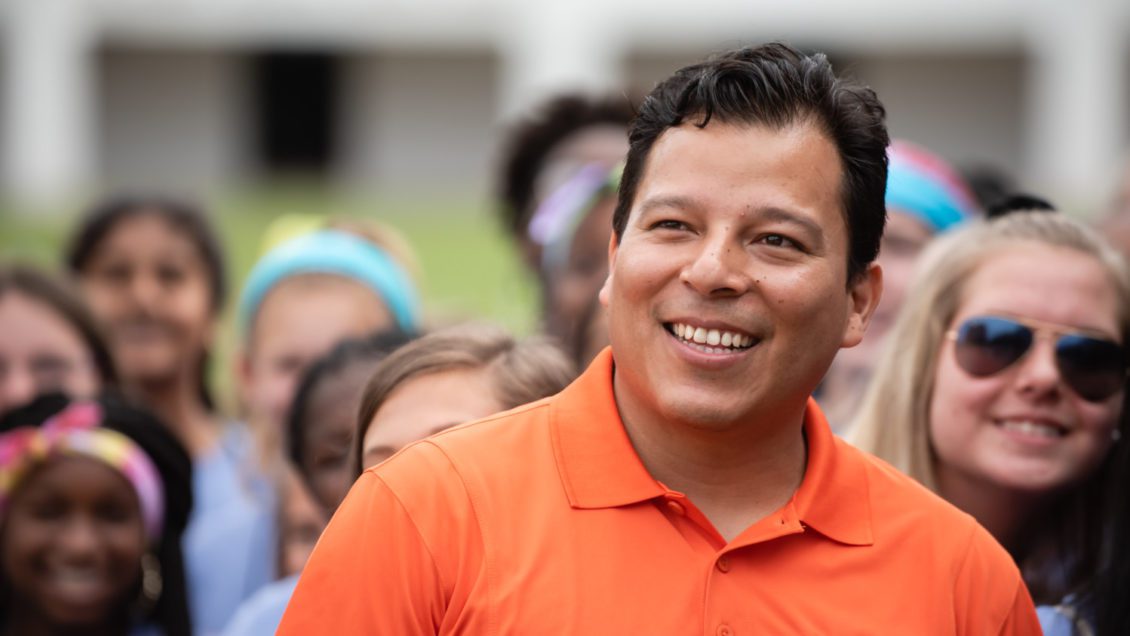Jorge Rodríguez of Clemson University begins his work days by rising as early as 4 a.m., climbing aboard a bus emblazoned with a friendly cartoon Tiger and driving to a middle school in South Carolina.

Sometimes he travels as far as Florence, sometimes as close to home as Pendleton or Seneca, but his mission is the same anywhere he goes. Rodríguez is showing students how the math and science they learn in the classroom can be used outside the schoolhouse doors.
He guides the students and their teachers through a series of hands-on lessons, such as designing a bridge and testing materials to see which are best at insulating heat.
In the six months he has been crisscrossing the state, Rodríguez has reached about 5,000 students.
He has received rave reviews for how he connects with them and has fielded several requests to return to the schools he has visited. The program he leads is so popular that he is already booked through the spring semester.
Rodríguez’s vehicle is a shuttle bus that has been refashioned into the EXPLORE Mobile Lab. The lab is a collaboration between Clemson University’s College of Engineering, Computing and Applied Sciences and Duke Energy, which provided $400,000 for the program.
“Engineers will lead our efforts to build the smarter energy infrastructure necessary for our state,” said Michael Callahan, Duke Energy’s state president in South Carolina. “There was no better partner than Clemson University to work with on this project. To see the results they’ve achieved in such a short time just shows our efforts together are raising interest in the field of engineering as a career for young students across our state.”
Brad Putman, associate dean for undergraduate students in the College of Engineering, Computing and Applied Sciences, said the lab has been an absolute success.
“All of us are thrilled at the work Dr. Rodríguez has done with the EXPLORE Mobile Lab,” Putman said. “The number of students he has reached and the positive feedback we are receiving are testaments to his hard work and gift for teaching. He is a key part of making this collaboration with Duke Energy a successful one.”
Rodríguez recently sat down with IDEAS Monthly to share what he has learned in his travels and some of his secrets to success.
What do you like best about your job?

I like the big impact. One of the things that I really enjoy is that I touch a lot of lives. I try to be very positive and not just introduce them to engineering but to help them think about how they are contributing to society. I tell the students, “We can not go the lazy route. Engineering is not easy. It’s difficult. A lot of people who came before you decided to go into engineering, and that’s why we have all the things that make our lifestyle better, like cars, computers and cell phones. We have to keep up with that so we can have the next technologies.”
You’re getting rave reviews for connecting well with students. Why do you think you relate so well to them?
Maybe because I’m enjoying it so much. I want to be very empathetic with them. Even before I started the program, I tried to remember what I was thinking when I was in middle school. What were my thoughts about the educational system? Did I know about engineering and other opportunities? And I realized that when I was in middle school, I didn’t know or knew very little about these things.
On top of that, I’ve tried to understand my audience. I think that makes a difference. In the beginning, I was using my own wordings. But then I started listening to students’ conversations. They say, “I can not do that because I’m ‘small brain’” or “Oh, you have a ‘big brain!’” I started picking up on that and using some of the same words.
What are some of the biggest misconceptions that middle school students have about engineering?
It is difficult for them to differentiate between the technical side of engineering and the intellectual side. It can be hard for them to understand the difference between being a mechanic and being a mechanical engineer. But there is a broad range of students. In some schools, they know very little, and in some they know very much and are very familiar with engineering. We try to serve all of them. But when we get requests from places that need more of our resources, we try to prioritize them first.
If there were one thing that could be done to get more students interested in STEM, what would it be?
Sometimes students think, “I’m doing this calculus, very complicated math. How is this relevant?” In these EXPLORE Mobile Lab classes, students see why they are learning math and science. They see, “Oh, that’s why I’m learning heat transfer. It applies directly if I were to work on a heater or AC unit.” The one thing I would say is make classes more relevant, and that basically means putting engineering into the school system.
What’s it like to have Duke Energy as a partner?
Duke has come to many of the events. They have been seeing the progress, and their engineers and managers give me ideas. I use Duke as an example with the students. I tell them, “In order to provide energy, they need a lot of engineers.” Duke has been crucial on this program.
Get in touch and we will connect you with the author or another expert.
Or email us at news@clemson.edu

